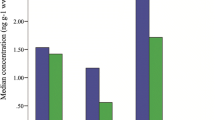Abstract
Background, Aims and Scope
The concentration of chlorinated dibenzo-p-dioxins and dibenzofurans in many fish from the Baltic requires monitoring, since it approaches or exceeds the European Union threshold limit value of 4 pg TEQ/g wet weight of fish for human consumption. The concentrations, expressed in TEQs, are important for toxicology and regulations, but hide the concentrations of the individual congeners, which are important for other environmental sciences, source allocation, and for the detection of measurement errors. This report evaluates the results of a survey reported earlier only in the terms of the TEQ concentrations.
Methods
Principal Component Analysis (PCA) was used to reduce the dimensions of the data (17 = 7 chlorinated dibenzo-p-dioxin and 10 chlorinated dibenzofuran congeners) to three principal components. This facilitated the interpretation of the congener profiles. Slopes of the congener concentrations as a function of age of the fish were estimated by least squares regression. The results were compared with a large set of data for lake trout from Lake Ontario.
Results and Discussion
The congener profiles of Baltic herring are less scattered than those of sprat. The profiles of herring from the central Baltic differ from those of herring from the Gulf of Riga and both appear to be affected relatively minimally by the age of the fish. The congener profiles of herring from the western Gulf of Finland are similar to those from the central Baltic, those from middle Gulf of Finland are similar to those from the Gulf of Riga. Both seem to be more affected by age of the fish than the profiles of the first two groups. The concentrations of several pentachloro- and hexachloro-dibenzo-p-dioxins and dibenzofurans increase with the age of the fish
Conclusion
PCA is a good technique for the evaluation of the congener profiles. The resulting loading and score plots provide a good graphic summary of the multidimensional data. Additional analyses are needed to confirm the observed profile patterns. A comparison with the results of a long-term monitoring from another area shows that the age of the fish is a more important factor than the year of capture.
Recommendation and Outlook
The surveys should continue for a number of years and the results should be presented and evaluated both in terms of the TEQs as well as in terms of weight concentrations. Since the concentrations do not appear to change very much from year to year, it would be better to carry out surveys only every 3–4 years and, instead, stratify the sampling according to age and gender of the fish, and to analyze replicate extracts by replicate measurements. The inclusion of unmarked replicate samples would be a good quality assurance measure. It would be desirable to analyze additional parts of the food chain in order to understand the fate of the compounds in the ecosystem.
Similar content being viewed by others
References
Billo EJ (2001): Excel for Chemists. A Comprehensive Guide. Wiley-VCH, New-York, 463p
Hallikainen A, Kiviranta H (2002): EU-kalat dioksiinitutkimushankehttp:/ /www.elintarvikevirasto.fi
Henkelmann B, Schramm KW, Klimm C, KettrupA (1996): Quality criteria for the Isotope dilution method with HRGC/MS. Fresenius J Anal Chem 354, 818–822
Huestis SY, Servos MR, Whittlle DM, van den Heuvel M, Dixon DG (1997): Evaluation of temporal and age-related trends of chemically and biologically generated 2,3,7,8-tetrachlorodibenzo-p-dioxin equivalents in Lake Ontario Lake trout, 1977 to 1993. Env Toxicol Chem 16,154–164
KlinkhardM (2001): How contaminated are fish and fish products? Eurofish 4, 102–104
Naito W, Jin J, Kang Y-S,Yamamura M, Masunaga S, NakanishiJ (2003): Dynamics of PCDDs/DFs and coplanar-PCBs in an aquatic food chain of Tokyo Bay. Chemosphere 53, 347–362
Olsson M, Bignert A, Aune M, Haarich, M, Harms U., Korhonen M, Poutanen E, Roots O, Sapota G (2002): Organic Contaminants. In: Environment of the Baltic Sea area 1994–1998. Baltic Sea Env Proc No 82B, HELCOM, 133–140
Otsa E, Roots O, Simm M (2003): Dioxin content in the Baltic Herring and Sprat in autumn 2002. Report-Estonian Environmental Research Centre (Contract No. 397 with Ministry of Agriculture), Tallinnhttp:// www.agri.ee/eng
Roots O, ZitkoV (2002): Polychlorinated biphenyls patterns in grey seals(Halichoerus grypus). Ecological Chemistry, Thesa 11, 68–71
Roots O, Lahne R, Otsa E, Simm M, Schramm K-W (2003): Dioxins in the Baltic herring and sprat in Estonian coastal waters. Organohalogen Compounds, 62, 201–203
The Baltic Marine Environment 1999-2002 (2003). Baltic Sea Environmental Proceedings, No 87, 47 pp
Vartiainen T, Parmanne R, Hallikainen A (1997): Ympäristömyrklcyjen kerty- minen silakkaan. YMPÄRISTÖ JA TERVEYS-LEHTI 7–8,18–22
Vuorinen P, Parmanne R, Vartiainen T, Keinänen M, KivirantaH, Kotovuori O, HailingF (2002): ICES Journal of Marine Science 59, 480–496
Wise BM, Gallagher NB (1998): PLS-Tool 2.0, Eigenvector Inc., Manson WA 98831, USA
Zitko V (2004): Chlorinated dibenzo-p-dioxins and dibenzofurans in an aquatic food chain. An evaluation by chemometrics http://preprint.chemweb.com/envchpm/0403001
ZitkoV (1994): Principal Component Analysis in the evaluation of environmental data. Mar Pollut Bull 28, 718–722
ZitkoV (1985): ’Shorthand’ numbering of chlorinated dibenzodioxins (CDD) and dibenzofurans (CDF). Chemosphere 14:165–170
Author information
Authors and Affiliations
Corresponding author
Rights and permissions
About this article
Cite this article
Roots, O., Zitko, V. Chlorinated dibenzo-p-dioxins and dibenzofurans in the baltic herrinj and sprat of estonian coastal waters. Environ Sci & Pollut Res 11, 186–193 (2004). https://doi.org/10.1007/BF02979674
Received:
Accepted:
Issue Date:
DOI: https://doi.org/10.1007/BF02979674




